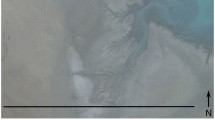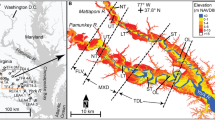Abstract
Average relative stream channel migration rates of .21 meters per year (.72 feet per year) for saline tidal wetland stream channels, and .32 meters per year (1.04 feet per year) for freshwater tidal wetland channels were calculated for a 32 year period (1940 to 1972) using photogrammetric techniques. Saline wetland stream channels averaged higher indices of sinuosity, i.e., the ratio of total channel length to linear downstream distance (1.95), when compared with sinuosities of freshwater tidal channels (1.46). The difference is attributed to differences in vegetation types and consequent soil holding capacity between saline and freshwater tidal wetland environments. Saline channels become entrenched because the banks are supported by dense root systems, while freshwater tidal channels flow through a more homogenous substrate and behave much like channels which cross mud-flats in the intertidal zone. Higher average meander amplitudes (one-half the peak to trough distance of a given meander wave) for saline channels (171 meters) versus lower amplitudes for freshwater channels (114 meters) suggest that meander loops for saline channels are determined primarily by the erosional characteristics of stream banks and by other local factors rather than by hydrodynamic factors such as flow velocity or discharge. It has been stated that meander migration features do not occur in homogenous soil materials (Leopold, et al. 1964); the tendency of saline channels to form these features is attributed to differential erosion caused by variations in root system density. Conversely, the morphology of freshwater tidal channels is influenced by hydrodynamic factors including discharge, and is due to the existence of more homogenous materials, i.e., muddy soils devoid of extensive root systems. An analysis of ebb and flood discharge data arrived at for each tidal channel using existing tidal current velocity and upland discharge records supports the fact that relatively greater erosive forces occur in salt marsh than in fresh tidal marsh areas. A poor statistical correlation between rates of stream channel migration and hydraulic stream flow data such as velocity and discharge must be accepted with caution due to the method of approximating tidal discharge values. The correlation suggests that under normal tidal conditions both saline and freshwater tidal channels migrate little, if any, and thus represent an apparently balanced relatively low energy system. For this reason it is believed that most stream channel migration in both saline and freshwater wetlands occurs as a result of increased forces due to storms.
Similar content being viewed by others
Literature Cited
Ahnert, F.. 1969. Estuarine meanders in the Chesapeake Bay area. Geogr. Rev. 50(3):390–401.
Campbell, M. R.. 1927. Meaning of meanders in tidal streams. Bulletin, Geol. Soc. Amer. 38:537–556.
Chapman, V. J. 1959. Discussion session, Salt Marsh Conference, Marine Institute, Sapelo Island, Georgia, March 1958 Proceedings, U. of Ga., 133 p.
Datagrid Digitizer, Bendix Computer Graphics, May 1975, 6 p.
Evans, G.. 1953. Some aspects of recent sedimentation in the Wash. Ecol. Geol. Helvetial 51(3):508–515.
Jakobsen, B. 1953. The foundation of ebb and flood channels in tidal channels described on the basis of morphological and hydrological observations. Geo. Tidaskr. 61.
Johnson, D. W.. 1929. Meanders in tidal streams: a review and discussions. Geogr. Rev. 19:135–139.
Leopold, L. B., M. G. Wolman, and J. P. Miller. 1964. Fluvial processes in geomorphology. W. H. Freeman and Company, New York, 522 p.
Pestrong, R.. 1965. The development of drainage patterns on tidal marshes. Stanford Univ. Publ., Geol. Sci. 10(2):87 p.
—. 1972. San Francisco Bay tidelands. San Francisco State College Publ. 1972:27–40.
Ragotzkie, R. A. 1959. Drainage patterns in salt marshes. Salt Marsh Conference, Marine Institute, Sapelo Island, Georgia, March 1958 Proceedings, U. of Ga., 22–28.
Redfield, A. C. 1959. The Barnstable Marsh. Salt Marsh Conference, Marine Institute, Sapelo Island, Georgia, March 1958 Proceedings, U. of Ga., 37–42.
Ryan, J., and T. Everitt. 1973. Investigations of the plant community-soil-soil strength-micromorphology relationships in coastal marshes. A Final Rept. on U.S. Army Research Office Grant #DA-ARO-D-31-124-72-g93, Lehigh U., 60 p.
Silberhorn, G. M., G. M. Dawes, and T. A. Barnard, Jr. 1974. Coastal wetlands of Virginia. Interim Rept. No. 3, Guidelines for Activities Affecting Virginia’s Wetlands, Spec. Rept. in Applied Manual Science and Ocean Engineering, No. 46, VIMS, 51 p.
Stevenson, R. E., and K. O. Emery. 1958. Marshlands at Newport Bay, Calif. Allan Hancock Foundation Publ., Occasional Papers 20:30 p.
Teal, J., and M. Teal. 1969. Life and death of the salt marsh, 2nd. Printing, 1972, Audubon/Ballantine Book, 274 p.
Van Veen, J. 1950. Eb en vloedschaar septemen in de Nederlandse geti jwartern, Ti jdschr Koninkl. Ned. Aardrijksk Gen. Amsterdam Wadden-Symposium, Groningen, Neth.
Author information
Authors and Affiliations
Rights and permissions
About this article
Cite this article
Garofalo, D. The influence of wetland vegetation on tidal stream channel migration and morphology. Estuaries 3, 258–270 (1980). https://doi.org/10.2307/1352081
Issue Date:
DOI: https://doi.org/10.2307/1352081




